
Future of Storytelling Festival in NYC
One thing (of many) we love about WE Communications is the agency’s focus on helping its people learn on a daily basis. Some of that includes mentoring, sharing insights with each other from award-winning client work, but also WE’s Continuing Education program, which helps us fine-tune our craft by creating meaningful employee experiences. Two of our employees recently had such an opportunity. Catch up with the adventures of Caitlin Valtierra, AE in New York, and Sarah Huerta, AAE in San Francisco, as they share their experience attending the Future of Storytelling festival in New York, as a part of WE’s Continuing Education program.
9:30 a.m. — All Aboard!
From the tip of Manhattan, we boarded the Staten Island Ferry then relived our high school days as we shuttled over in yellow buses to Snug Harbor Cultural Center and Botanical Garden. After checking in and wandering the grounds, we grabbed a booklet and outlined our day in the event app. Not only did the app provide interactive maps and details on each activity, but it also sent push notifications to let us know when to start heading over to our “starred” panels.
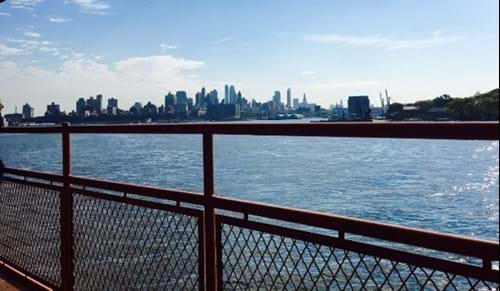
12:30 p.m. — Panel: Redefining Identity Through the Lens of the Media
“One of my favorite inventions in television is the end of the story.” – Joe Lewis, head of Comedy, Drama & VR, Amazon Studios
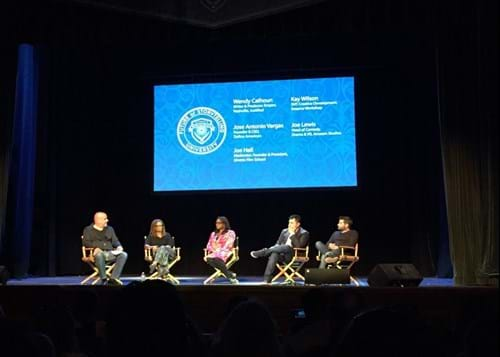
Our first panel of the day was joined by executives and creative leaders from Amazon Studios, Define American and Sesame Workshop, as well as the writer and producer from popular TV shows “Empire” and “Nashville.” The panelists discussed how media shapes our perspective of identity and contributes to defining stereotypes that may become ingrained in our vernacular. An interesting point brought up by one panelist is that identity is twofold. On one side is what you perceive of yourself, and on the other side is the set of expectations that others impose onto you. Deciding how to balance these two components is the tricky part, but fostering an environment at work or at home that welcomes debate on gender and race topics is one way to start the conversation.
The panelists agreed that storytelling through media is an incredibly powerful way of redefining identity by inspiring empathy and understanding. To do this effectively, they emphasized the value of immersing oneself in an experience to write about it authentically. Whether this is done through intensive research or fieldwork, empathy and authenticity prove to be essential components of effective storytelling across industries, from the writer’s room to the PR strategy we offer clients on a daily basis.
2 p.m. — Panel 2: The Future of VR
"We need to start thinking of VR as a major art form" – Sol Rogers, founder/CEO, REWIND
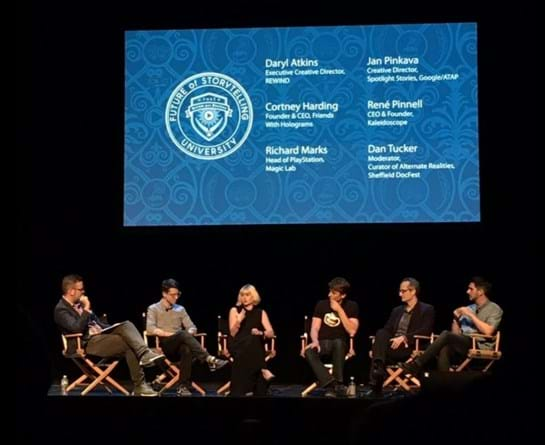
This panel featured creators, storytellers, VCs and studio execs from companies like Google, Kaleidoscope and REWIND discussing the current consumer adoption rate of VR and how companies can better leverage the technology as a means to engage audiences in truly interactive storytelling. While some panelists believed VR enthusiasts live in a “virtual” bubble, others argued nearly a third of Americans have used some type of VR and the average American has a VR-capable smartphone. With this in mind, storytellers need to start thinking about the consumer’s VR experience across all platforms.
Another valid point panelists made was regarding the prejudice against VR, conveying that it’s an isolating, single-user experience. Because of this, it’s imperative for brands to focus on how to be interactive and create shared experiences. This dovetails into the idea that brands should infuse VR into public places from pop-ups to partnerships with brick and mortar stores. Location-based exhibits will enable consumers to take turns and watch each other use the equipment and then engage in conversations about what they’ve watched or experienced themselves. In these instances, VR also offers us a significant opportunity to implement and celebrate diversity. Brands can create worlds and experiences that allow users to better understand different worldviews and virtually walk in each other’s shoes.
3:30 p.m. – Playtime, Finally!
After absorbing some awesome learnings from the day’s panels, we decided it was time to get our hands on some VR tech! We found an outdoor bookstore with books on the evolution of storytelling and technology and stumbled upon our Microsoft pals showing off their HoloLens and demoing a few of their newest (and unreleased) mixed-reality simulations. We tried on an assortment of different headsets and played games that allowed us to swim to the depths of the ocean, experience the lifecycle of a tree firsthand, and even become giants, using lamp posts to “paint” the night sky with newborn stars.
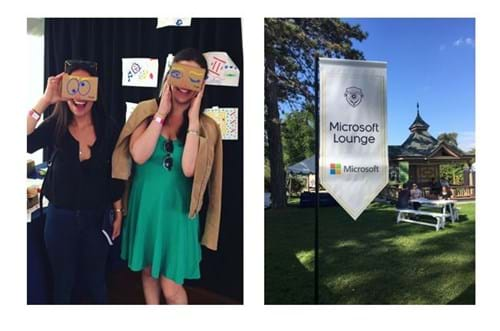
5 p.m. — Refuel and Return to Manhattan
It was a long day of learning, and we were ready to refuel before heading back into the city. In true millennial fashion, Sarah gravitated toward the Instagram-friendly, jungle-themed MatchaBar booth. Meanwhile, Caitlin kept it simple (read: not basic) and grabbed a pretzel.
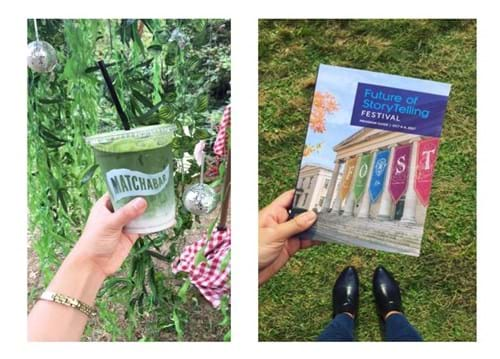
As the Staten Island ferry took us back to Manhattan, we traded insights gleaned from the day and reflected on our overall experience. Learning how leaders across the tech and media space are integrating virtual and mixed realities into consumers’ lives was not only an amusing and interactive experience, but it also gave us new perspective on the reasons why and methods in which we share stories. As we continue to work with brands to actively bring to life both spotlight moments and long-term campaigns, we’ll remember to consider the role of interactive storytelling and the value of cultivating shared experiences to further connect with audiences.
This post was written by Caitlin Valtierra and Sarah Huerta.
The latest blogs from WE
Decoding Gen Alpha: A Primer on the Next Gen of Consumers
Why Gen Alpha Will Fuel Spending This Season
Why Reputation Is a Business Driver in Healthcare

